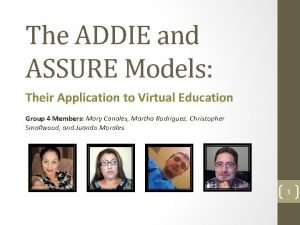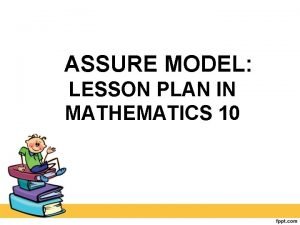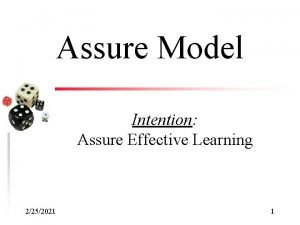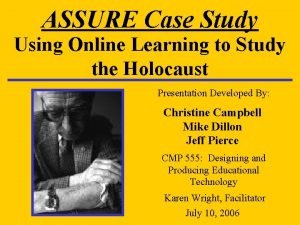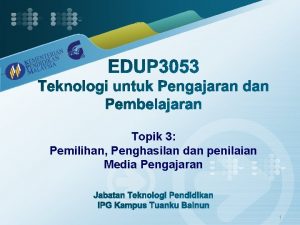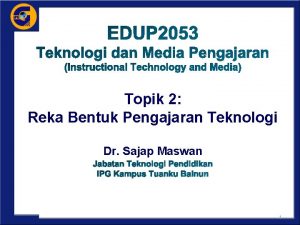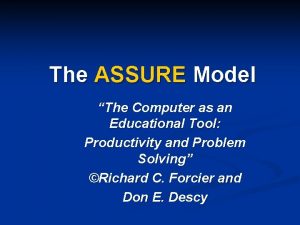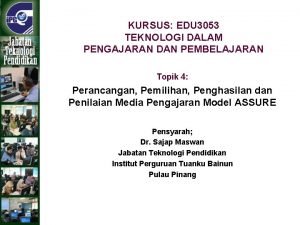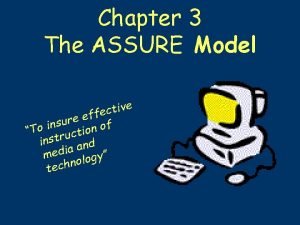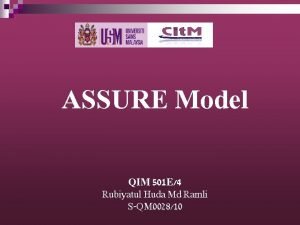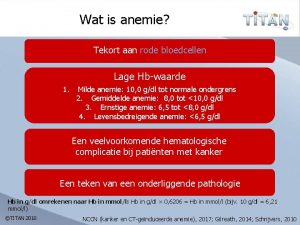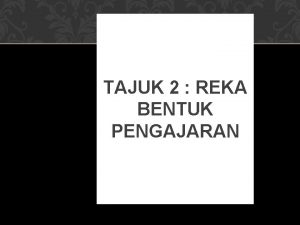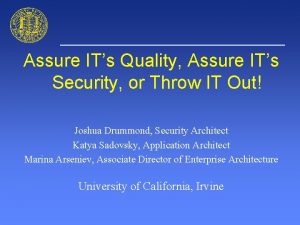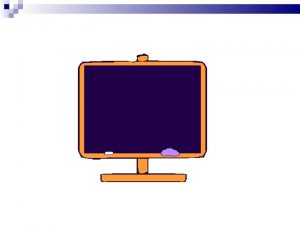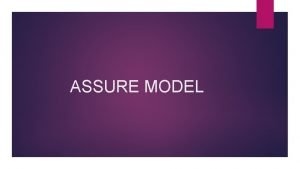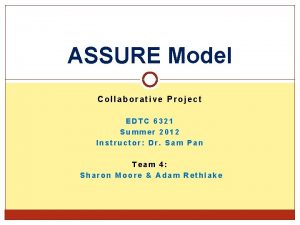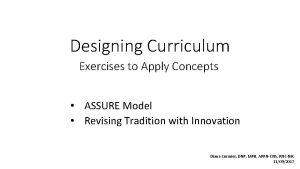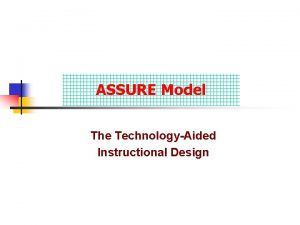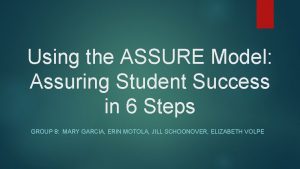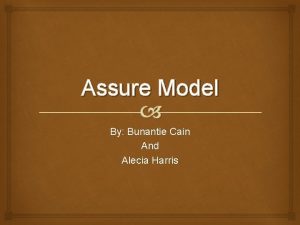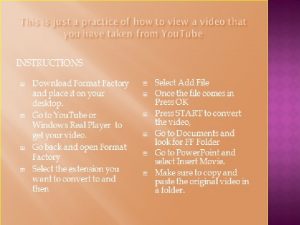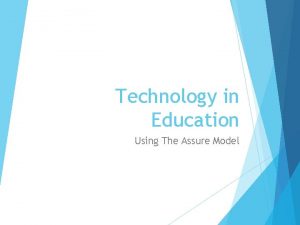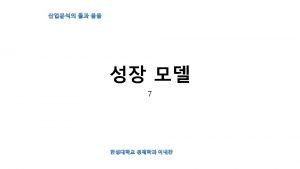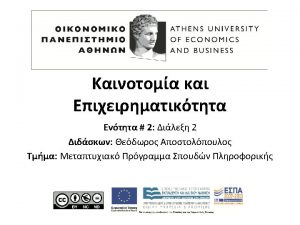Chapter 3 The ASSURE Model e v i






















- Slides: 22

Chapter 3 The ASSURE Model e v i t c e f f e e r u s n “To i uction of instr and a i d e ” m y g o l no h c e t

A Analyze the Learners

Analyze Learners Matching the characteristics of the learner with the content of the methods, media, and materials General Characteristics - identify your learners Specific Entry Competencies - know what your learners are capable of doing Learning Styles - how an individual perceives, interacts with and responds emotionally to the learning environment

Learning Styles Gardner says, “not all people have the same abilities; not all people learn in the same way. ”

Information Processing Habits • Concrete Sequential-direct hands-on experiences in logical order – – Workbooks Programmed instruction Demonstrations Structured laboratory approaches

Information Processing Habits • Concrete Random-lean toward a trial and error approach – – Games Simulations Independent study projects Discovery Learning

Information Processing Habits • Abstract Sequential-learners decode verbal and symbolic messages adeptly – Reading presentations – Listening to presentations

Information Processing Habits • Abstract Random-draw meaning from human mediated presentations respond to tone and style of speakers – – Group discussions Lectures with question answer periods Videotapes Television

S State the Objectives

State Objectives A statement of what will be achieved, not how it will be achieved Audience - learning takes place when learners are active, mentally processing an idea, or physically practicing a skill. Behavior -the verb describing the new capabilities that the audience will have after instruction Conditions -the performance that is to be observed by the learners Degree -the standard by which acceptable performance will be judged

S Select Method, Media, and Materials

Select Method, Media, and Materials Choosing a Method -any given lesson will probably incorporate two or more methods to serve different purposes at a different points in the progression of the lesson Choosing a Media -the physical form in which a message is incorporated and displayed - still images, text, voice, music, etc. Selecting Materials -available -modify existing -design new

U Utilize Media and Materials

Utilize Media and Materials Use of media and materials by the students and teachers. Preview the materials -always preview instruction materials before using them -materials should be appropriate for your audience and objectives Prepare the materials -gather all of the equipment you and the students will need -determine the sequence Prepare the environment -arrange the facilities for proper student use of the materials and media

Utilize Media and Materials Use of media and materials by the students and teachers. Prepare the learners -give a broad overview of the content and lesson or -tell how the lesson relates to the topic being studied or -give a motivating statement that creates a need to know by telling learners how they will profit from the lesson -give cues directing attention to specific aspects of the lesson Provide the learning Experience -direct attention to the classroom

R Require Learner Participation

Require Learner Participation Active participation in the learning process enhances learning. Behaviorist Perspective -learning is a process of trying various behaviors and keeping those that lead to favorable results. Cognitivists Perspective -learners build up a mental schemata when their minds are actively engaged in struggling to remember or apply a new concept or principle Constructivists Perspective -learning is an active process where knowledge is built on the basis of experience Social Psychologists Perspective -interpersonal communication as the social basis for knowledge acquisition

Feedback Productive critical evaluative response – Oneself – Print Sources – Devices – Other People

E Evaluate and Revise

Evaluate and Revise Designed to detect and correct learning/teaching problems and difficulties with the instruction that may interfere with student achievement Assessment of Learner Achievement -Did students learn what they were suppose to learn? Evaluation of Methods and Media -Were the instructional methods and materials effective? Revision -What changes need to be made in the lesson?

The ASSURE Model Analyze the Learners State the Objectives Select Methods, Media, and Materials Utilize Materials Require Learner Participation Evaluate and Revise

THE END Presentation by Pennie Hoard ETEC 562
 Assure and addie models
Assure and addie models Assure lesson plan
Assure lesson plan Assure lesson plan sample
Assure lesson plan sample Sample lesson plan using assure model
Sample lesson plan using assure model Disadvantage of assure model
Disadvantage of assure model Assure model instructional design
Assure model instructional design Assure model essay
Assure model essay Who developed the assure model
Who developed the assure model Cara penilaian media pengajaran
Cara penilaian media pengajaran Reka bentuk pengajaran model assure
Reka bentuk pengajaran model assure Assure model
Assure model Rph model assure
Rph model assure Model assure
Model assure Assure model
Assure model Profylaxe
Profylaxe Model berorientasikan bilik darjah
Model berorientasikan bilik darjah Hình ảnh bộ gõ cơ thể búng tay
Hình ảnh bộ gõ cơ thể búng tay Frameset trong html5
Frameset trong html5 Bổ thể
Bổ thể Tỉ lệ cơ thể trẻ em
Tỉ lệ cơ thể trẻ em Gấu đi như thế nào
Gấu đi như thế nào Glasgow thang điểm
Glasgow thang điểm Chúa yêu trần thế alleluia
Chúa yêu trần thế alleluia
